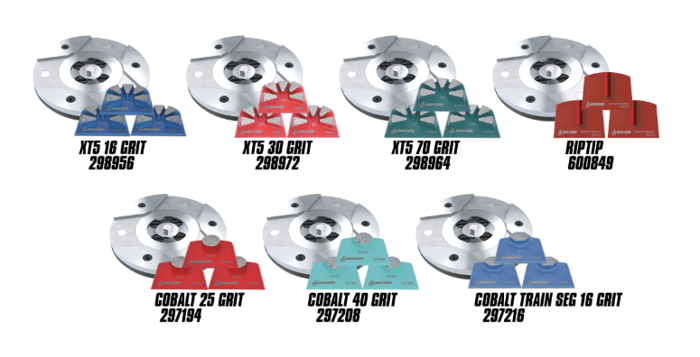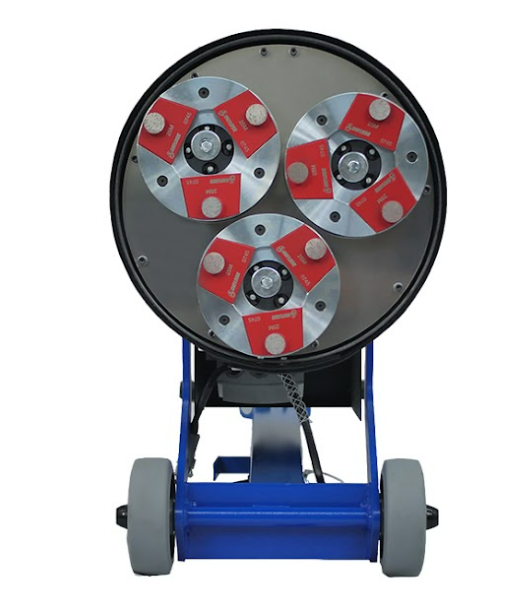Updated April 26, 2023
Concrete grinding is an essential step in many construction and renovation projects. It helps to level uneven surfaces, remove imperfections, and prepare the concrete for coatings or polishing. One critical factor in achieving a successful concrete grinding job is choosing the right diamond grit size.
Diamond grit size refers to the size of the diamond particles embedded in the grinding tools. It plays a crucial role in determining the efficiency, speed, and quality of the grinding process. In this article, we will explore the different diamond grit sizes available and guide you on how to choose the right diamond grit size for your concrete grinding job.
The Importance of Selecting the Correct Diamond Grit Size
Diamond tools used in hard concrete grinding have a wide range of grit sizes. Diamond grinding is the process of using a diamond abrasive to remove material from a hard surface. The diamond abrasives are bonded to a metal or resin matrix, which is then attached to a grinding machine or other equipment.
The diamond grit size refers to the size of the individual diamond particles on the abrasive disk. The size of the diamond grit is measured in microns, with smaller micron numbers indicating larger diamond particles.
Choosing the correct diamond grit size when grinding concrete is important because it affects how much material is removed from the surface and how quickly the work is completed.
A larger grit size will remove more material but will also leave a rougher surface, while a smaller grit size will remove less material but will leave a smoother surface. It's important to choose the right grit size for your specific job to ensure that you achieve the desired finish without damaging the surface or your equipment.

Understanding Diamond Grit Sizes
Diamond grit sizes are indicated by numbers that represent the size of the diamond particles in the grinding tool. The lower the number, the larger the diamond particles, and the coarser the grit size.
Conversely, the higher the number, the smaller the diamond particles, and the finer the grit size. Diamond grit sizes typically range from 16 to 3000, with 16 being the coarsest and 3000 being the finest.
Coarse Grit (16-40)
Coarse diamond grit sizes such as 16-40 are used for aggressive grinding and removal of thick coatings, adhesives, and uneven surfaces. They are typically used in the initial stages of concrete grinding when the surface is severely damaged or needs to be leveled.
Medium Grit (40-80)
Medium diamond grit sizes like 40-80 are used for general grinding and removal of moderate coatings, adhesives, and imperfections. They are commonly used in the intermediate stages of concrete grinding to refine the surface after the initial coarse grinding.
Fine Grit (100-200)
Fine diamond grit sizes such as 100-200 are used for fine grinding and polishing of the concrete surface. They are typically used in the final stages of concrete grinding to achieve a smooth and polished finish.
Extra Fine Grit (400-3000)
Extra fine diamond grit sizes like 400-3000 are used for fine polishing and honing of the concrete surface. They are used to achieve a high gloss and mirror-like finish on the concrete surface.

Factors to Consider When Choosing Diamond Grit Size
Choosing the right diamond grit size for your concrete grinding job depends on several factors. It's crucial to consider these factors to ensure that you achieve the desired results efficiently and effectively. Here are some factors to consider when choosing diamond grit size:
Surface Condition
The condition of the concrete surface you are grinding is a crucial factor in determining the appropriate diamond grit size. If the surface is heavily damaged, has thick coatings, or uneven patches, a coarse diamond grit size such as 16-40 may be required for aggressive grinding and removal.
For moderately damaged surfaces, a medium grit size like 40-80 may be suitable for general grinding and surface refinement. If the surface is in relatively good condition and requires polishing, a fine or extra fine diamond grit size may be appropriate. For soft concrete, soft bond is preferred.
Grinding Goals
Diamond tooling is available in various grit sizes, and each one is suitable for different grinding goals. The goals of your concrete grinding job also play a role in choosing the right diamond grit size.
If you are aiming to remove coatings or adhesives quickly, a coarse grit size may be necessary. If you are looking for a polished finish, a fine or extra fine grit size may be needed. Consider the end result you want to achieve and choose the diamond grit size accordingly.
Equipment and Speed
The type of grinding equipment and the speed at which you are grinding also influence the diamond grit size selection. Different grinding machines have different capabilities, and their performance can vary with different diamond grit sizes.
Coarse grits are typically used with high-speed grinders, while finer grits are used with low-speed grinders. It's essential to consult the manufacturer's guidelines to ensure that you select the right diamond grit size for your equipment.
A diamond grinding cup wheel with a finer grit size can produce a smoother finish on the concrete surface than a coarse grit size.

Common Mistakes to Avoid When Selecting Diamond Grit Size
Concrete polishing and grinding is a delicate process, and selecting the wrong diamond grit size can lead to a range of mistakes.
One of the most common mistakes people make when selecting diamond grit size is assuming that a higher grit number is always better. However, this is not always the case.
While a high grit number can produce a very smooth surface, it may not be the best choice for all applications. For example, if you need to remove a lot of material quickly, a lower grit number may be more appropriate.
Another mistake is not considering the hardness of the surface you are grinding. Harder surfaces require a higher diamond grit number to effectively remove material.
If you use too low of a grit number on a hard surface, the diamond particles will wear down quickly, reducing the effectiveness of the abrasive disk and causing damage to your equipment.
How to Determine the Diamond Grit Size You Need
The diamond grit size you need for your concrete grinders will depend on several factors, including the type of surface you are grinding, the amount of material you need to remove, and the desired finish.
Here are some general guidelines to follow:
- For heavy material removal, use a lower diamond grit number, such as 16-40.
- For moderate material removal, use a medium diamond grit number, such as 70-120.
- For light material removal and a smooth finish, use a higher diamond grit number, such as 200-400.
However, keep in mind that these are just general guidelines, and the specific diamond grit size you need will depend on the unique characteristics of your job.
Tips for Grinding Smarter, Not Harder
Now that you understand the importance of selecting the correct diamond grit size, here are some additional tips for grinding smarter, not harder:
- Use the right equipment. Make sure you have the right grinder, disk, and other equipment for the job.
- Keep the disk clean. Clean the diamond abrasive disk regularly to prevent clogging and ensure maximum effectiveness. The diamond cup wheel should spin freely and not be overworked.
- Use a steady hand. Keep the grinder steady and move it in a smooth, even motion to prevent damage to the surface and your equipment.
- Use water. Water can help control dust and prevent the surface from overheating, which can cause damage to the diamond abrasive disk.
Techniques for Using Diamond Grit Effectively
To use diamond grit effectively for your concrete floor, it's important to follow the right techniques. Here are some tips to keep in mind:
- Start with a lower diamond grit number and work your way up to higher grits. This will help you achieve a smoother surface and prevent damage to your equipment.
- Use overlapping passes. Make sure each pass overlaps the previous one by about one-third to ensure even material removal.
- Keep the disk level. Make sure the diamond abrasive disk is level with the surface being ground to prevent uneven material removal and damage to your equipment.
- Use a consistent speed. Keep the grinder at a consistent speed to prevent damage to the surface and your equipment.
Tools and Equipment for Grinding with Diamond Grit
To effectively grind with diamond grit, you'll need the right tools and equipment. Here are some things to consider:
- Grinder: A high-quality grinder is essential for effective diamond grinding. Look for a grinder with a variable speed control and a dust collection system.
- Diamond abrasive disk: Choose a high-quality diamond abrasive disk with the right grit size for your job.
- Dust collection system: A dust collection system is important for controlling dust and preventing damage to your equipment.
- Safety gear: Wear safety gear, including eye protection, ear protection, and a dust mask, to protect yourself from dust and debris.
Conclusion
In conclusion, selecting the correct diamond grit size is crucial to grinding smarter, not harder. By choosing the right grit size for your specific job, you can maximize efficiency, achieve the desired finish, and minimize damage to your equipment.
Avoid common mistakes, follow the right techniques, and use the right tools and equipment to ensure a successful grinding project. With these tips in mind, you'll be able to tackle any grinding job with confidence and ease.

0 comments